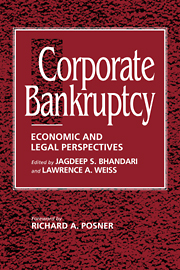Book contents
- Frontmatter
- Contents
- List of tables and figures
- Foreword by the HONORABLE RICHARD A. POSNER
- Preface
- Part I The role of credit
- Part II Bankruptcy as a reflection of the creditors' implicit bargain
- Part III Beyond the basic creditors' bargain
- Part IV Workouts or bargaining in the shadow of bankruptcy
- Part V Alternatives to bankruptcy and the creditors' bargain
- Part VI Experience of other countries
- 29 Lessons from a comparison of U.S. and U.K. insolvency codes
- 30 The costs of corporate bankruptcy: A U.S.–European comparison
- 31 Should we abolish Chapter 11? The evidence from Japan
- 32 The role of banks in reducing the costs of financial distress in Japan
- Index
32 - The role of banks in reducing the costs of financial distress in Japan
Published online by Cambridge University Press: 10 December 2009
- Frontmatter
- Contents
- List of tables and figures
- Foreword by the HONORABLE RICHARD A. POSNER
- Preface
- Part I The role of credit
- Part II Bankruptcy as a reflection of the creditors' implicit bargain
- Part III Beyond the basic creditors' bargain
- Part IV Workouts or bargaining in the shadow of bankruptcy
- Part V Alternatives to bankruptcy and the creditors' bargain
- Part VI Experience of other countries
- 29 Lessons from a comparison of U.S. and U.K. insolvency codes
- 30 The costs of corporate bankruptcy: A U.S.–European comparison
- 31 Should we abolish Chapter 11? The evidence from Japan
- 32 The role of banks in reducing the costs of financial distress in Japan
- Index
Summary
Introduction
The increase in leverage of many U.S. corporations in the 1980s has touched off a public debate about its effect on economic activity. In one view, large debt burdens constrain investment and threaten financial stability; in another, they prevent corporate waste and improve economic performance. Either way, high leverage increases the likelihood that firms will be unable to make their debt payments, and it raises concern about what happens to these distressed firms. Some argue that, as long as a firm has good prospects, financial distress will have no real impact; the firm's debt will be renegotiated to ensure its survival. Others take a less sanguine view: Creditors' conflicting claims make renegotiation difficult and may lead creditors to liquidate the firm even though it is collectively inefficient for them to do so.
Both theories of financial distress have some appeal, but there are virtually no facts to lead us to one or the other. In this chapter we attempt to bring some evidence to bear on this question. We analyze how financial distress affects firm's investment behavior and their performance in product markets. Our empirical evidence suggests that financial distress is costly for firms that are likely to have significant conflicts among their creditors.
The evidence is from Japan. We focus on Japanese firms because of the kind of financial environment in which they operate. Many firms in Japan have very close ties to a main bank.
- Type
- Chapter
- Information
- Corporate BankruptcyEconomic and Legal Perspectives, pp. 531 - 549Publisher: Cambridge University PressPrint publication year: 1996
- 1
- Cited by



